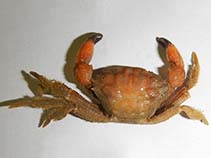Monodaeus couchii (Couch, 1851)
Couch rubble crab| Native range | All suitable habitat | Point map | Year 2050 |

|
| This map was computer-generated and has not yet been reviewed. |
| Monodaeus couchii AquaMaps Data sources: GBIF OBIS |
Classification / Names Common names | Synonyms | CoL | ITIS | WoRMS
Malacostraca | Decapoda | Xanthidae
Environment: milieu / climate zone / depth range / distribution range Ecology
Benthic; depth range 60 - 1300 m (Ref. 2708). Subtropical; 64°N - 27°N, 37°W - 29°E
Distribution Countries | FAO areas | Ecosystems | Occurrences | Introductions
Eastern Atlantic and the Mediterranean: from England to Angola and the Mediterranean.
Length at first maturity / Size / Weight / Age
Maturity: Lm ?, range 1 - 1.6 cm
Deep-sea species living on muddy substrates of the outer shelf and continental slope (Ref. 106817). Found on sublittoral areas to a depth of 1300 meters, on rocky coral banks, with sponges, muddy sand, shells, and pebbles (Ref. 2708). Opportunistic predator but appears to be able to deposit feed and scavenge. Preyed upon by many epibenthic crabs and fishes (Ref. 106817).
Life cycle and mating behavior Maturity | Reproduction | Spawning | Eggs | Fecundity | Larvae
Members of the order Decapoda are mostly gonochoric. Mating behavior: Precopulatory courtship ritual is common (through olfactory and tactile cues); usually indirect sperm transfer.
Main reference
References | Coordinator | Collaborators
MarineSpecies.org. 2050. (Ref. 3477)
IUCN Red List Status (Ref. 130435)
CITES status (Ref. 108899)
Not Evaluated
CMS (Ref. 116361)
Not Evaluated
Threat to humans
Harmless
Human uses
Fisheries: commercial
| FishSource |
Tools
More information
Internet sources
BHL | BOLD Systems | CISTI | DiscoverLife | FAO(Publication : search) | Fishipedia | GenBank (genome, nucleotide) | GloBI | Gomexsi | Google Books | Google Scholar | Google | PubMed | Tree of Life | Wikipedia (Go, Search) | Zoological Record



